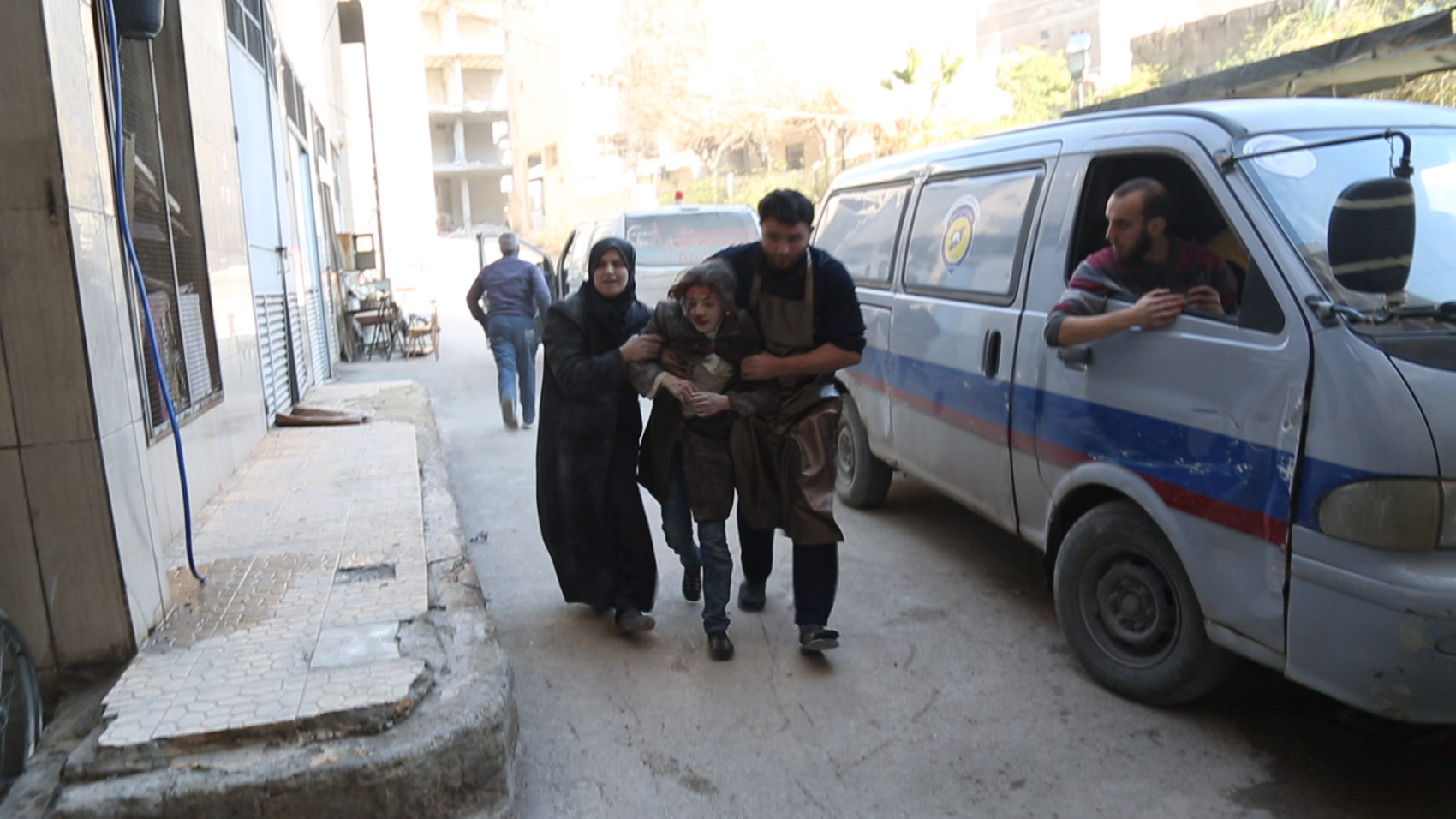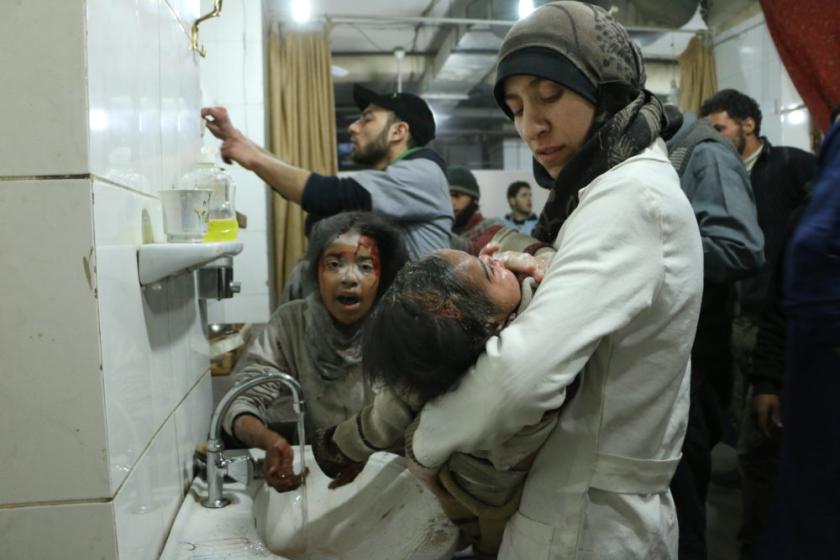War crimes are war crimes, irrespective of the victims’ ages, gender, or ethnicities, and no one’s torture or murder is more abhorrent than anyone else’s. Yet because children are essentially innocent and incapable of defending themselves, and perhaps because they are barely equipped to process why governments, nations, and armed forces would want to eliminate them, their maiming and killing is an obscenity beyond compare.
This is a way of saying that The Cave, the latest documentary directed by the Syrian filmmaker Feras Fayyad, maker of 2017’s Last Man in Aleppo, is as imperative a watch as it is a gruelling one. It is seen from the perspective of – and partially narrated by – Dr. Amani Ballor, a pediatrician who turned 30 during the course of the filming. Manager of a hospital in a warren dug beneath Eastern Ghouta, the so-called rebel stronghold of 400,000 trapped citizens near Damascus that was besieged by Bashar al-Assad’s regime and its Russian allies between 2013 and 2018, Ballor saved numerous children’s lives.
Time and time again, Fayyad shows kids being rushed into the hospital after a bombing raid and Dr. Amani, as she’s known, making instant diagnoses and treating victims on the spot, coaxing bits of rock and shrapnel from babies and toddlers’ mouths, for example. In one tears-inducing scene, she tends a little girl with henna-stained hands who, seemingly little harmed by a bombing moments before, is evidently in shock; Amani’s tenderness keeps the girl smiling, even as she mentions her father’s recent killing by a car bomb, and plants the seed in her that she, too, could one day become a doctor, or a teacher. As we get to know Amani, so we do three of her equally heroic colleagues in the hospital of 150 staff. There is Samaher, the stoical nurse who, though she suffers memory lapses, cooks, cleans, and keeps everyone’s spirits up with her rowdy humour. Surgeon Dr. Salim, a classical-music lover, plays YouTube concert videos on his propped-up smartphone – the music is in lieu of anaesthesia, he says – while he operates. Alaa is the unflappable young woman doctor, who accompanies Amani on a dangerous excursion beyond the hospital to visit a little girl with blood cancer and a baby boy who can’t sit up owing to malnutrition. Since only the government and the Red Cross can permit the girl and her mother’s evacuation, Amani curses Assad, not for the only time in the film. God, too, gets a rebuke from her, and you can see why.
As we get to know Amani, so we do three of her equally heroic colleagues in the hospital of 150 staff. There is Samaher, the stoical nurse who, though she suffers memory lapses, cooks, cleans, and keeps everyone’s spirits up with her rowdy humour. Surgeon Dr. Salim, a classical-music lover, plays YouTube concert videos on his propped-up smartphone – the music is in lieu of anaesthesia, he says – while he operates. Alaa is the unflappable young woman doctor, who accompanies Amani on a dangerous excursion beyond the hospital to visit a little girl with blood cancer and a baby boy who can’t sit up owing to malnutrition. Since only the government and the Red Cross can permit the girl and her mother’s evacuation, Amani curses Assad, not for the only time in the film. God, too, gets a rebuke from her, and you can see why.
In one especially upsetting sequence, children struggling to breathe are brought into the hospital following the chlorine attack of April 7, 2018, that led to 500 people being admitted to different medical facilities. A mother howls as she realizes her son, glimpsed briefly on a gurney, has died; Salim buries his head in his hands and weeps after this atrocity, as Amani weeps on another occasion and Samaher goes into a near fugue state. However, it would be wrong to say the film is unflinching. Fayyad necessarily avoids showing the worst of what happened, and leaves Amani to state, as she, Salim, and Samaher are evacuated at the end, “No one can imagine the things we’ve seen”, and “I’m afraid that what I saw will haunt me forever”.
The Cave’s disturbing subtext is the ingrained misogyny that Amani has to deal with as a female physician and hospital administrator. Early in the film, an aggrieved young husband calls on the hospital to complain that he can’t get medication for his wife owing to what he believes is the incompetent management of Amani, whom, he says, “should be at home with her children”; Salim rushes to her defence. Amani’s father, speaking to her on a phonecall, complains that people are whispering that she shouldn’t work as a doctor. When Amani offers a hospital job to the mother of the malnourished boy and his two siblings to help her pay for medications, the woman says the men in her family wouldn’t allow it. Blaming men’s exploitation of religion for this oppression, Amani vows to fight it, as if she hasn’t got enough on her plate.
I saw The Cave a few days after seeing Sam Mendes’s single-shot World War I film 1917 and was struck by the similarity between the network of tunnels that comprised the hospital and the Western Front trenches through which Mendes’s camera follows two British infantrymen on a crucial mission. (National Geographic’s financing of The Cave enabled Fayyad to include a digital map of the Eastern Ghoutta labyrinth that rather flashily disappears into a closeup of one of Amani’s eyes.) Worthy though 1917 is (if aesthetically problematic), it struck me as sad that more people will likely see it, as a big entertainment movie, than The Cave – the horrendous real-life events it depicts having occurred while most of us have been living comfortable Western lives. To not see it – and Waad Al-Kateab and Edward Watts’s likeminded For Sama, as well – is to bury one’s head in the sand.














Add comment